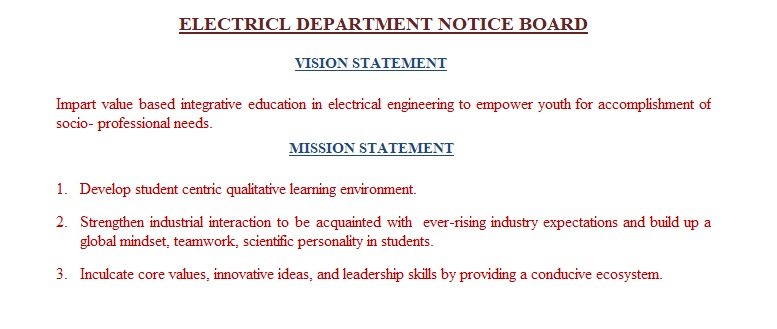Syllabus for first MID semester Examination:
Electrical Drives and Control 2160912
1.
Introduction:
• History
Of DC Drive -Electronic Control -Solid State Control
• State Of Art Of DC Drive
• Block Diagram Of Drive
• Components Of Electrical Drive and
their functions
2. Dynamics of Electrical Drives
·
Types of Load-Quadratal diagram of speed
·
Torque characteristics –
·
Types and Characteristics of load torque –
·
Dynamics of motor- load combination –
·
steady state & transient stability of an
electrical drive –
·
Determination of moment of inertia- Load
equalization
3.
DC drives Speed-torque characteristics
·
DC separately excited, shunt and series motors
·
Modified
speed-torque characteristics with resistive control
·
Analysis
for speed-torque equations in terms of firing angle and duty cycle;
·
Modified speed-torque characteristics with phase
controlled converters and DC-DC converters for continuous conduction and
discontinuous conduction
·
Closed
loop speed control schemes
·
Dynamic model of DC machine
·
Speed and
position control scheme using the dynamic model
4. Scalar
control of AC machines
·
Review of V/f control
·
VSI based
Induction Motor control
·
Harmonics
and Harmonic torques with VSI
·
Selection of carrier frequency and harmonic
spectrum
·
Advantages of V/f control over other scalar
control techniques
·
Various operating modes for doubly fed induction
machine: Sub-synchronous and super-synchronous motoring and generating
·
Static
Scherbius drive: Design aspects like speed range, power factor, ratings of
components
·
Closed-loop speed control schemes: slip control,
current limit control
·
CSI fed
IM
·
Speed-torque characteristics with current
source
Comparison with VSI based control Syllabus for second MID semester Examination:
Above syllabus +
6.
Applications of Electric Drives
·
Introduction to Solar and battery powered
Drives;
·
Introduction to traction Drives;
·
Servo motor drive requirement – control and
implementation
Question Bank( Electrical Drives &Control)
Unit :1
1) Enlist advantages of electrical drives.
2) State essential part of electrical drives.
3) What are the functions of power modulator?
4) Draw block diagram of electrical drive and
explain briefly function of each block.
5) What is electrical drive?
6) Enlist factors to be considered for selection
of electrical drive.
Unit :2
1) Explain different types of load on electrical
drives.
2) Explain quadrilateral diagram of speed and
torque characteristic (four quadrant operation)
3) Write a note on load torque and its
classification.
4) Dynamic equation of motor load combination.
5) Determination of moment of inertia of a motor.
6) Write a note on stability of an electrical
drive.
7) Write a note on load equalisation.
Unit :3
1) Explain speed torque characteristics of
separately excited D.C. motor.
2) Explain speed torque characteristic of DC
shunt motor.
3) Explain speed torque characteristic of DC series
motor.
4) Explain speed torque characteristic of PMDC
motor.
5) Explain dynamic model of DC motor drive.
6) Explain speed control methods of DC series
motor.
7) Explain speed control methods of DC shunt
motor.
8) Explain ward leonard method of speed control.
9) Explain the 1-ɸ half wave
converter drive for the speed control of separately excited dc motor with
waveform.
10) Explain the 1-ɸ full wave converter drive for
the speed control of separately excited dc motor with waveform.
11) Explain the 1-ɸ semi converter drive for the speed
control of separately excited dc motor with waveform.
12) Explain the 1-ɸ dual converter drive for the speed control of separately
excited dc motor with waveform.
13) Explain the 3-ɸ half
wave converter drive for the speed control of separately excited dc motor with
waveforms at α=30˚, α=150˚.
14) Explain chopper
controlled drive operation modes for the speed control of separately excited dc
motor with waveform.
15) Explain principle of
regenerative barking and speed control (2nd quadrant operation) of
drive using chopper.
16) Explain working of
2-quadrant operation of drive using chopper.(1st and 2nd
quadrant operation)
17) Give 3points of
comparison between converter fed dc drives and chopper fed dc drives.
18) Explain speed and
position control scheme of dc motor using dynamic model of dc motor.
Unit :4
1) Explain speed torque characteristics of
separately excited D.C. induction mortor.
2) Explain stator voltage control of induction motor.
3) Explain V/f control of induction motor.
4) Explain the effect of non sinusoidal supply on
VSI
5) Explain unipolar and bipolar PWM method for inverter.
6) Explain speed control methods of DC series
motor.
7) Explain speed control methods of DC shunt
motor.
8) Explain ward leonard method of speed control.
9) Enlist advantages of V/f
control.
10) Explain the operating modes of doubly fed
induction machine.
11) Explain working of static scherbius drive.
12) Explain closed loop speed control of
induction motor using slip control scheme.
13) Explain closed loop speed control of
induction motor using current limit control scheme.
14) Explain closed loop speed control of CSI fed induction
motor drive.
15) Give 7 points of
comparison between CSI and VSI.
Solve numericals based on
theory and formulas used in chapter 2,3 and 4.

No comments:
Post a Comment